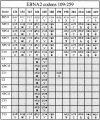Latent gene sequencing reveals familial relationships among Chinese Epstein-Barr virus strains and evidence for positive selection of A11 epitope changes
- PMID: 14557637
- PMCID: PMC229270
- DOI: 10.1128/jvi.77.21.11517-11530.2003
Latent gene sequencing reveals familial relationships among Chinese Epstein-Barr virus strains and evidence for positive selection of A11 epitope changes
Abstract
Epstein-Barr virus (EBV) strains from the highly HLA-A11-positive Chinese population are predominantly type 1 and show a variety of sequence changes (relative to the contemporary Caucasian prototype strain B95.8) in the nuclear antigen EBNA3B sequences encoding two immunodominant HLA-A11 epitopes, here called IVT and AVF. This has been interpreted by some as evidence of immune selection and by others as random genetic drift. To study epitope variation in a broader genomic context, we sequenced the whole of EBNA3B and parts of the EBNA2, 3A, and 3C genes from each of 31 Chinese EBV isolates. At each locus, type 1 viruses showed <2% nucleotide divergence from the B95.8 prototype while type 2 sequences remained even closer to the contemporary African prototype Ag876. However, type 1 isolates could clearly be divided into families based on linked patterns of sequence divergence from B95.8 across all four EBNA loci. Different patterns of IVT and AVF variation were associated with the different type 1 families, and there was additional epitope diversity within families. When the EBNA3 gene sequences of type 1 Chinese strains were subject to computer-based analysis, particular codons within the A11-epitope-coding region were among the few identified as being under positive or diversifying selection pressure. From these results, and the observation that mutant epitopes are consistently nonimmunogenic in vivo, we conclude that the immune selection hypothesis remains viable and worthy of further investigation.
Figures






Similar articles
-
HLA-A11-restricted epitope polymorphism among Epstein-Barr virus strains in the highly HLA-A11-positive Chinese population: incidence and immunogenicity of variant epitope sequences.J Virol. 2003 Nov;77(21):11507-16. doi: 10.1128/jvi.77.21.11507-11516.2003. J Virol. 2003. PMID: 14557636 Free PMC article.
-
T cell responses and virus evolution: loss of HLA A11-restricted CTL epitopes in Epstein-Barr virus isolates from highly A11-positive populations by selective mutation of anchor residues.J Exp Med. 1994 Apr 1;179(4):1297-305. doi: 10.1084/jem.179.4.1297. J Exp Med. 1994. PMID: 7511684 Free PMC article.
-
Epstein-Barr virus latent gene sequences as geographical markers of viral origin: unique EBNA3 gene signatures identify Japanese viruses as distinct members of the Asian virus family.J Gen Virol. 2011 May;92(Pt 5):1032-1043. doi: 10.1099/vir.0.030023-0. Epub 2011 Jan 19. J Gen Virol. 2011. PMID: 21248177
-
Genome diversity of Epstein-Barr virus from multiple tumor types and normal infection.J Virol. 2015 May;89(10):5222-37. doi: 10.1128/JVI.03614-14. Epub 2015 Mar 18. J Virol. 2015. PMID: 25787276 Free PMC article.
-
Immune escape by Epstein-Barr virus (EBV) carrying Burkitt's lymphoma: in vitro reconstitution of sensitivity to EBV-specific cytotoxic T cells.Int Immunol. 1992 Nov;4(11):1283-92. doi: 10.1093/intimm/4.11.1283. Int Immunol. 1992. PMID: 1282031
Cited by
-
Sequence analysis of Epstein-Barr virus EBNA-2 gene coding amino acid 148-487 in nasopharyngeal and gastric carcinomas.Virol J. 2012 Feb 21;9:49. doi: 10.1186/1743-422X-9-49. Virol J. 2012. PMID: 22348267 Free PMC article.
-
Human herpesvirus diversity is altered in HLA class I binding peptides.Proc Natl Acad Sci U S A. 2022 May 3;119(18):e2123248119. doi: 10.1073/pnas.2123248119. Epub 2022 Apr 29. Proc Natl Acad Sci U S A. 2022. PMID: 35486690 Free PMC article.
-
Out-of-Africa migration and clonal expansion of a recombinant Epstein-Barr virus drives frequent nasopharyngeal carcinoma in southern China.Natl Sci Rev. 2024 Nov 28;12(4):nwae438. doi: 10.1093/nsr/nwae438. eCollection 2025 Apr. Natl Sci Rev. 2024. PMID: 40160679 Free PMC article.
-
Autophagy and ATP-induced anti-apoptosis in antigen presenting cells (APC) follows the cytokine storm in patients after major trauma.J Cell Commun Signal. 2011 Jun;5(2):145-56. doi: 10.1007/s12079-010-0113-z. Epub 2011 Jan 13. J Cell Commun Signal. 2011. PMID: 21484192 Free PMC article.
-
HLA-A11-restricted epitope polymorphism among Epstein-Barr virus strains in the highly HLA-A11-positive Chinese population: incidence and immunogenicity of variant epitope sequences.J Virol. 2003 Nov;77(21):11507-16. doi: 10.1128/jvi.77.21.11507-11516.2003. J Virol. 2003. PMID: 14557636 Free PMC article.
References
-
- Abdel-Hamid, M., J. J. Chen, N. Constantine, M. Massoud, and N. Raab-Traub. 1992. EBV strain variation: geographical distribution and relation to disease state. Virology 190:168-175. - PubMed
-
- Burrows, S. R., and A. D. Hislop. The immune response to Epstein-Barr virus. In A. C. Tselis and H. B. Jensen (ed.), The Epstein-Barr virus, in press. Marcell Dekker, Inc., New York, N.Y.
-
- Cheung, S.-T., S.-F. Leung, K.-W. Lo, K. W. Chiu, J. S. L. Tam, T. F. Fok, P. J. Johnson, J. C. K. Lee, and D. P. Huang. 1998. Specific latent membrane protein 1 gene sequences in type 1 and type 2 Epstein-Barr virus from nasopharyngeal carcinoma in Hong Kong. Int. J. Cancer 76:399-406. - PubMed
Publication types
MeSH terms
Substances
Grants and funding
LinkOut - more resources
Full Text Sources
Other Literature Sources
Research Materials

